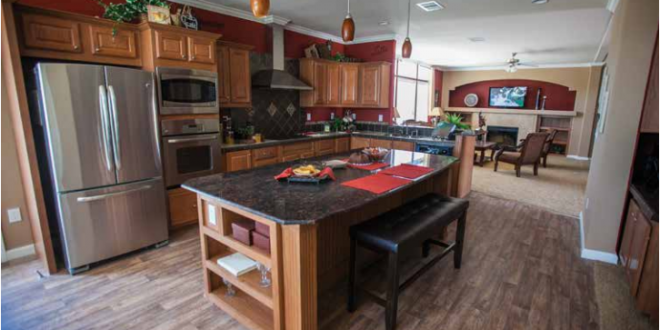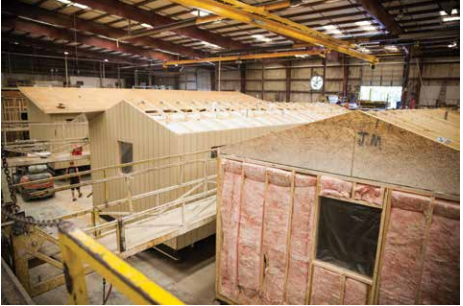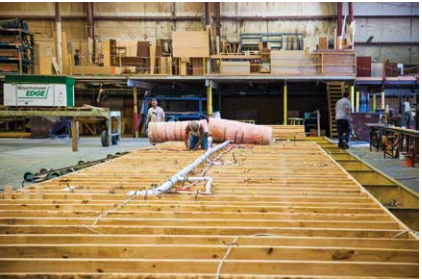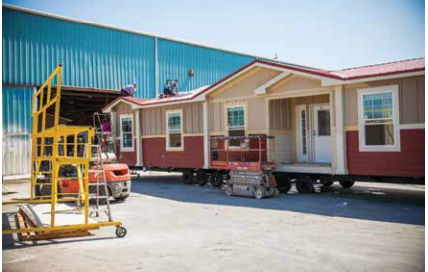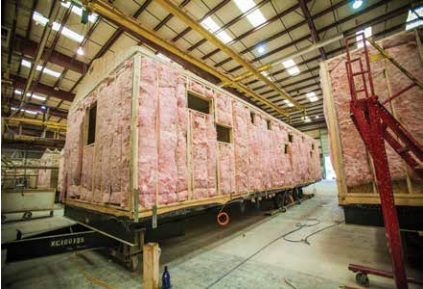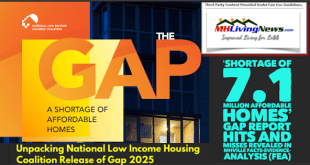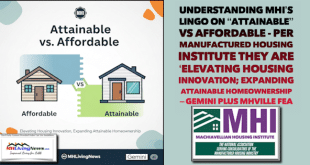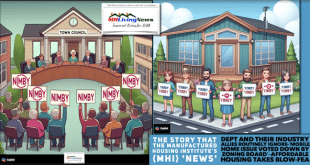by Harold D. Hunt, PhD,
The Real Estate Center at Texas A&M University

Before 1976, each state created its own regulations for the construction of mobile homes. As a result, while cross-state sales were allowed, the construction codes from state to state were inconsistent. In these early years, affordability was a high priority and little consideration was given to energy efficiency.
In 1976, the U.S. Department of Housing and Urban Development (HUD) created the Federal Manufactured Home Construction and Safety Standards, commonly known as the “HUD code.” When the legislation went into effect on June 15, 1976, mobile homes were officially defined as “manufactured homes” in federal law.
These federal standards regulate the design, construction strength, durability, transportability, fire resistance and energy efficiency of manufactured housing.
The HUD code has been periodically updated based on recommendations made by the Manufactured Housing Consensus Committee, a group of users, producers, general interest and public officials charged with making recommendations to improve the code.
Manufactured housing should not be confused with “modular housing.” While all manufactured homes are regulated by the HUD code, modular homes are subject to local building codes in the jurisdiction where the home is located.
In Texas, all residential modular homes are built to the International Residential Code, 2006 Edition; the National Electrical Code, 2011 Edition; and International Energy Conservation Code, 2009 edition, the same building codes site-built homes adhere to. In coastal counties, they must also meet the Texas Windstorm construction requirements.
Modular housing is still a relatively new housing option.
“Texas builds about 12 times more manufactured homes than modular,” says Ronnie Richards, vice president of marketing for American Homestar Corporation, builder of Oak Creek and Platinum brand manufactured homes.
Manufactured Housing Sales in Texas
Numbers published by the Texas Manufactured Housing Association (TMHA) show that single-section homes are still the most popular product, although double and triple-section units are gaining in popularity (see table).
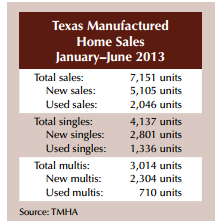
“Texas is by far the leading state in sales of new manufactured homes with about 20 percent of all units sold in the country,” according to DJ Pendleton, executive director of the TMHA.Source: TMHA
Buyer Preferences Don’t Always Include Energy Efficiency
It should come as no surprise that manufactured home buyers are often more concerned with housing affordability or interior décor options than energy efficiency. The industry is attempting to educate their buyers on the advantages of more energy efficient homes even though upgrades involve an increase in upfront cost.
“It’s pretty difficult for buyers to visualize future electricity bill savings. And many times they would rather spend any extra funds on upgrading their cabinets or countertops,” says Richards. “Lifestyle and local electricity rates will vary as well, so it’s hard for buyers to calculate the exact amount of utility savings they would receive.”
All-electric manufactured homes are by far the most popular choice with Texas buyers.
Some companies are vertically integrated, manufacturing, selling and financing their manufactured homes. These companies have an added incentive to see homeowners keep utility costs low, since lower utility bills can improve affordability and reduce the chances of a loan default.
“Most manufacturers encourage potential buyers to tour the factory so they can see the product being built today,” says Charley Boyer, chief operating officer/vice president of the Manufacturing Division for Oak Creek Homes. “Unfortunately, I think the really old manufactured housing that’s still out there hurts a buyer’s perception of our industry more than old single-family homes do in the site-built sector.”
Energy Efficiency Upgrades Coming in Many Forms
Initiated in 1992, the Energy Star label has become a well known symbol of improved energy efficiency. The Energy Star program is now a joint effort between the Environmental Protection Agency (EPA) and the U.S. Department of Energy.
An Energy Star certified manufactured home is approximately 30 percent more energy efficient in its heating, cooling and water heating than a comparable unit built to the HUD code. To receive an Energy Star certification and label for a manufactured home, a third-party representative must fill out a form certifying all program criteria has been met after the home has been manufactured, delivered and installed.
Most builders of manufactured housing offer Energy Star certified homes as an option.
“Although we haven’t decided to yet, my company has pondered whether we should build only Energy Star homes,” says Boyer.
Some manufacturers will offer their own branded energy efficiency packages. For example, Cavco Industries markets their EnerGmiser option under their Palm Harbor label and the PowerSaver option under their Masterpiece line of manufactured housing.
The packages offer buyers a specific set of energy efficient upgrades that, subject to specified assumptions, have been calculated to save Texas homeowners anywhere from $10,000 to $25,000 in heating and cooling costs over the life of a 30-year mortgage. This translates to about $28 to $70 per month in savings.
Components of these packages include:
- higher insulated and sealed airtight ducts,
- graduated air delivery systems to balance air flow from room to room,
- high performance air return systems to minimize outside airflow into the home,
- section seals to minimize the intrusion of outside air and water vapor,
- a whole-house insulation rating of R-54 and
- optimally sized HVAC systems for superior cooling and humidity performance.
“The EnerGmiser package is actually standard on the majority of our home models. However, it is still an option on a few. For example, on an approximate 1,400-square-foot home it would add about $400 to the cost,” says Charlie Hill, vice president of sales and marketing for Palm Harbor Homes.
“On a monthly basis, that would be a nominal payment increase. But the upside is a lower utility expense and more comfortable living environment.”
A final option is to allow the buyer to choose any combination of individual efficiency upgrades to stay within their affordability limits. Hill has noted a fairly consistent hierarchy in the energy efficient features being chosen today.
“If I were to rank the popularity of our energy efficiency options with buyers, the order would probably be: 1) radiant barrier in the roof, 2) increased insulation in the ceiling, 3) upgrades to 2×6 studs for more insulation in the exterior walls, and 4) low-e dual-pane windows,” says Hill.
“Our buyers have a lot of flexibility in choosing energy efficient options as well,” says Boyer. “For example, in my Fort Worth plant we use R-11 insulation in the floor, R-13 in walls and R-30 in the ceiling. A buyer can go as high as R-22 in the floor, R-19 in walls and R-38 in the ceiling. But the extra cost for that level of insulation upgrade would be over $2,000.”
“Substituting double-pane windows for single-panes would probably cost an additional $150 per window,” notes Boyer. “And our homes will average anywhere from 12 to 15 windows.”
Keith Alexander, division president and general manager of Palm Harbor’s Austin manufacturing plant, is a big proponent of adding radiant barriers to manufactured housing.
“We use several products such as Kool-Ply or TechShield for our radiant barriers,” says Alexander.
“It’s not scientific, but I ran my own attic temperature test on two completed homes here in our yard one summer day. The models were exactly alike except for the presence of a radiant barrier in one of them. We recorded a 15 degree lower attic temperature in the home with the radiant barrier.”
Alexander says the cost to add radiant barrier decking to a 2,300-square-foot double-section home is about $800, which would add just over $2 a month to a 30-year mortgage payment. Assuming financing as short as seven years, monthly loan payments would still only increase little more than $10 per month.
THE PROCESS BEGINS with floor assembly
(previous page, top), then proceeds to framing
(this page). The plant’s controlled environment and
repetitive building techniques reduce variance in
construction quality. The completed home rolls off
the assembly line ready for delivery
Energy Efficiency Research Limited
Several research groups have looked into the energy efficiency of manufactured housing during the last couple of decades, including the Florida Solar Energy Center and North Carolina A&T University.
“I wish the manufactured housing industry had more R&D money,” says Richards. “We try to team up with product suppliers as much as we can to improve the energy efficiency of components going into manufactured housing.”
“The black mold scare back in the 1990s drove a lot of research related to ductwork and HVAC systems,” says Bert Kessler, vice president of engineering for Palm Harbor homes. “We discovered that duct leakage and oversizing of HVAC systems were big factors in mold growth.”
Optimizing HVAC systems and advanced ductwork sealing techniques resulted in some of the most dramatic improvements in both indoor air quality and overall energy efficiency. Simulations showed an 18 to 20 percent annual energy savings could be attained through these two changes alone.
Leakage where multiwide sections join was another serious problem that was solved with the development of one continuous insulated gasket along the “marriage line” joining the sections together for a tight seal.
The Oregon Office of Energy conducted research on the energy efficiency of Energy Star homes. Tested Energy Star certified manufactured homes added about $8 per month on average to the typical mortgage while saving an average of $30 per month on heating and cooling bills.
Another group, the Systems Building Research Alliance (SBRA) located in New York City, is also heavily involved in energy efficiency research. SBRA is a research arm of the factory-built housing industry and the EPA’s national quality assurance oversight agent for manufactured and modular home Energy Star programs.
The SBRA has recently begun to look into the viability of ductless heat pump systems. The system, which is already being used in some site-built homes, runs only refrigerant lines from the main compressor through the walls to remote fan units throughout the home.
“The challenge has been to set the efficiency bar high but still reach buyers that normally can’t afford the added cost. They generally derive the greatest benefit from energy savings,” said Emanuel Levy, SBRA executive director.
Economic Incentives Sparse
Texas currently offers no state incentives for the purchase of energy efficient manufactured housing. A limited number of states and local utilities offer economic incentives for manufactured homes that are Energy Star certified. Homeowners in North Carolina can receive utility rate discounts, South Carolina and New Mexico offer state income tax credits to homeowners and California offers tax rebates to manufactured housing retailers.
The Tennessee Valley Authority (TVA), Clayton Homes and the SBRA are working together to increase the TVA’s level of energy efficient manufactured housing. Supported by a cash incentive of $1,450 per home from TVA to the home manufacturers, Clayton Homes has announced that all manufactured homes it builds in the six-state TVA region will qualify for the Energy Star label.
The TVA reports that electric bills are lowered by $70 per month on average, providing thousands of dollars in savings over the life of the home.
Although buyers have been less than enthusiastic thus far, the manufactured housing industry continues to press on with improvements to the energy efficiency of their homes. More information about regulations and research relating to manufactured housing can be found at:
http://www.tdhca.state.tx.us/mh/index.htm,
http://www.research-alliance.org/pages/home.htm and
http://www.license.state.tx.us/ihb/ihb.htm#url.
___________________

“Copyright 2013. Real Estate Center at Texas A&M University. Photos and article published with permission.”
 manufacturedhomelivingnews.com Manufactured Home Living News
manufacturedhomelivingnews.com Manufactured Home Living News
